Have you ever looked at your web statistics and found that your bounce rates are high and your conversion rates are low? You know that this isn’t a good sign, but you have no idea why it’s happening or how to fix it. So what now? What you need is insights into why your customers behave the way they do. Luckily, there are several tools and software that can help you with this! In this blog, we take a closer look at some of the best user experience tools on the market right now.
To improve both your bounce rate and your overall conversion rate, you want to consider your user experience (UX). Have you heard of UX before but are not sure of the specifics? Don’t worry, we’re here to give you answers.
User experience includes all aspects of user interaction with your company, your services and/or products. You might think that your company’s website works well, but the big question is: do your customers agree? If you’re not able to answer this question, it’s definitely time to start digging into what the user experience of your website or mobile app looks like.
The design process of a good website is now more complex than ever. The success of your company depends on the needs of your customers. Fortunately, there are countless user experience tools that facilitate the entire process. That is why we have made an overview of some great tools to help you determine which of these are best for your business:
For this overview, we have defined five categories of User Experience (UX) tools:
- Customer feedback tools
- UX analytics and event-tracking tools
- Session recording and heatmapping tools
- A/B and split testing tools
- Usability feedback tools
- Design and wireframing tools
Note:
We have added licence costs of the tools in the overview (where possible). Many of these company websites (not surprisingly) use A/B testing for pricing so the price tends to vary quite a bit, and business models change over time. Therefore the price figures for each of these tools will not be updated regularly. They were confirmed the date of this blog post’s publication.
Customer feedback tools
Customer feedback tools help you collect insights from your customers and set up your very own voice of the customer programme. Tuning into your users’ thoughts and feelings helps you identify both what works with your service or product and what needs improvement. When done correctly, this can have a huge impact on your overall user experience.
1. Mopinion
About Mopinion for websites
Mopinion (hi, that’s us!) is the #1 feedback software for web, app and email. We also take feedback one step further with in-depth analysis opportunities for our users. With real-time data visualisation in customisable dashboards and charts, users are able to quickly and efficiently digest large sums of data. Our ‘one-stop shop’ offers:
- An easy-to-use interface
- Customisable forms, built with a drag-and-drop functionality
- Conversational, chat-like feedback forms
- Visual Feedback
- Surveys that include question routing
- In-depth analysis, including text analytics, sentiment analysis, smart labeling, etc.
- Automatically generated charts
- Advanced data visualisation with in-chart filtering and customisable dashboards
- User management that allows you to control who has access to your feedback campaigns and in what way (i.e. viewing, editing, etc.)
- Self-hosted surveys: No need for Javascript to set up your surveys
- Single Sign-On (Microsoft Entra ID, OKTA and Google)
- Native SDKs: Fully native feedback on your app. No redirection is needed
- And much more
Interested? Start your free trial today or request a demo.
2. HubSpot

Source: HubSpot
HubSpot’s built-in feedback tools simplify capturing both qualitative and quantitative insights, helping you better understand your customers. With HubSpot, you can design and distribute surveys through email and on your website, and consolidate all customer feedback on a unified dashboard accessible to your entire team. Utilize a Net Promoter Score (NPS) survey to gauge customer loyalty over time, send Customer Effort Score (CES) surveys to assess the ease of obtaining support, or deploy customer satisfaction (CSAT) surveys to measure satisfaction at various stages of the customer journey.
3. SurveyMonkey
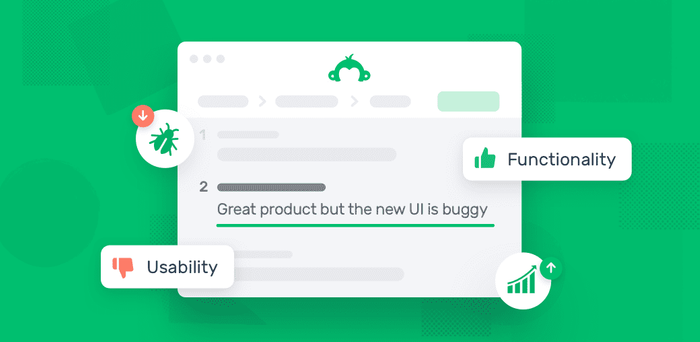
Source: SurveyMonkey
SurveyMonkey is a well-known tool that offers 15 types of questions (such as multiple choice, Likert scales, and open comments). This makes it a flexible survey software, perfect for longer, tradtional surveys or one-off surveys. SurveyMonkey’s pricing differs depending on if you are looking for an individual plan or a team plan, but start at €30 per month and customer prices for enterprises.
4. Qualtrics
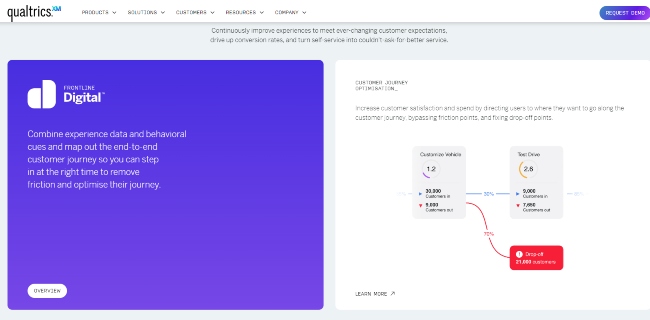
Source: HubSpot
Qualtrics is an experience management software that provides a comprehensive online survey solution. Offering over 100 question types, it includes survey templates and features such as display logic, email triggers, and logic branching. Its real-time web reports allow users to select from more than 30 different graph types and export results to CSV or SPSS. However, it is worth noting that this solution is designed for larger businesses and comes with a higher price tag. Prices are given on request.
UX analytics and event-tracking tools
UX analytics and event-tracking tools enable user researchers to understand what their website visitors are doing on their website. This knowledge is useful for determining if a particular design change will be effective before you implement it. On the other hand, these tools don’t tell you “why” a user does something. One of the most well-known tools that fall under this category is Google Analytics. But if you’re looking for more specialised tools in regards to click and event analysis, it might be beneficial to consider these:
1. Omniconvert – REVEAL
![]()
Source: Omniconvert
Omniconvert’s REVEAL is a UX analytics software that analyses your customers’ behaviour and helps you retain them by uncovering their needs.
The NPS function allows you to track the customer journey from start to finish and pinpoint any particular stores, pages or services that drag down your overall score. REVEAL also allow you to track how your users interact with your website, such as buying habits and customer lifetime value, giving you insights into both what your customers do and why.
The price? It varies depending on the size of your company and how many views your site gets. But the price plans start at $273 a month.
2. Chartbeat

Source: Chartbeat
Chartbeat focuses on content intelligence and analytics, giving the user insight into reader engagement. With this tool, you can determine where your best content and traffic sources are. Filter users by location, devise or visitor frequency and uncover which pages get the most traffic. All is possible with Chartbeat! Filter users by location, devise or visitor frequency and uncover which pages get the most traffic.
Website: www.chartbeat.com
3. Mixpanel
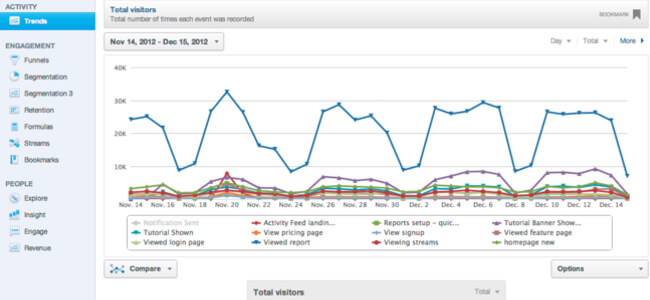
Source: Mixpanel
Mixpanel really focuses on user interactions with both website and mobile applications. This tool provides targeted communication with visitors (including e-mails and smart notifications), in-app A/B tests and user survey forms. Additionally, you can visualise the data collected in less than 10 minutes. Another benefit? Mixpanel offers a ‘freemium’. However, if you want more access with additional services, they have a custom pricing model all the way up to the enterprise level.
Website: www.mixpanel.com
4. Woopra

Source: Woopra
Woopra also offers real-time data-driven analytics, enabling you to easily analyse different segments and funnels on your website. The tool creates customer segments that automatically update as user behaviour changes. Using these segments and profiles, users can create funnel reports, custom reports and retention reports. Pricing for this tool is catered to both small businesses (free and up to $999/month) and enterprises (custom pricing).
Website: www.woopra.com
5. UXcam

Source: UXcam
UXcam helps users capture every micro-interaction on your mobile app, it helps identify usability issues on mobile applications and make informed product decisions. With UXcam you can use session recording, heatmap & screen analytics, user analytics, funnel analytics and more. It is also possible to attach UXCam’s sessions to your crash reports, allowing your development team to replay associated sessions of crashes.
Website: www.uxcam.com
6. Keen

Source: Keen
Bring together all events from your website, app, device or webstore and save it on Keen. This tool is a third-party application that shows and shares data in self-service reports and dashboards. Keen makes customer analyses much easier thanks to APIs that collect only the data that you want. In this way, you will find the right answers, which are saved in the Cloud. Keen’s pricing varies from a free version to $699/month.
Website: www.keen.io
7. Matomo

Source: Matomo
Matomo is a self-hosted or cloud-based web analytics tool focused on privacy. Among other things, Matomo tracks what your visitors are doing on your website. This tool is a bit like Google Analytics, but not entirely the same: You host and manage your own data with Matomo, rather than Google’s servers. The data is available in real-time. The on-premise version of this software is free to download. Would you like the hosted variant? Then prices start at €22/month depending on your monthly traffic.
Website: www.matomo.org
Session recording and heatmapping tools
This is also a form of quantitative research. On one hand, you can track entire sessions, including full recordings of how the users moves about on your website or app (session recording). On the other hand, you can recognise patterns using heatmapping at page level to see how users interact with the page (for example, where the mouse moves, mouse activity or where they click).
1. Smartlook

Source: Smartlook
Smartlook is a qualitative analytics solution for websites and mobile apps. They help over 200,000 businesses of all sizes and industries answer the “whys” behind their users’ actions. With a unique feature set, Smartlook finally gives you a way to understand user behavior at the micro level. Always-on visitor recordings show you what every last visitor does on your website or app, while automatic event tracking lets you know how (and how often) your visitors do specific things. You can then build conversion funnels to see your conversion rates as well as uncover why people are churning. Heatmaps for websites give you mass data about where most people click, scroll, hover and otherwise interact with your pages.
Smartlook offers a free package that includes 3,000 monthly sessions as well as a Pro plan package (€55/month) and an Enterprise plan with pricing on request.
Website: www.smartlook.com
2. MouseStats

Source: MouseStats
With MouseStats you know exactly what your visitors are doing. View all mouse movements, scrolls, keystrokes and clicks as a movie. Thanks to interactive heatmaps, you can see exactly which parts of the page attract attention as well as where they don’t. The price of MouseStats ranges between $29 to $299 a month, depending the number of recordings.
Website: www.mousestats.com
3. Crazy Egg

Source: Crazy Egg
Crazy Egg offers several types of heatmaps that enable the user to analyse visitor behaviour. Where do they click? Do they scroll to the bottom of the page? What are they looking at? These are questions that Crazy Egg answers. Implementation of this tool is easy and the reporting features are even easier. An advantage: you can use Crazy Egg for free for the first thirty days. After the thirty days are up, the tool can cost between $9 and $99 per month. There are also packages for premium plans that range between $189 to $2499 a month.
Website: www.crazyegg.com
4. Contentsquare

Source: Contentsquare
Contentsquare is an experience analytics platform that offers zone-based heatmaps, journey analyses, frustration scoring and a lot more.
This allows you to quickly identify which areas on your website cause the most friction and frustration. At the same time the zone-based heatmaps also show you where your customers convert, what causes them to click and what grabs their attention. Test your campaigns with a side-by-side heatmap A/B testing and get actionable insights that will improve your marketing efforts.
5. Inspectlet

Source: Inspectlet
By way of videos, this tool ensures that you know exactly what your visitors are doing on your website. Each mouse movement, scroll, click and keypress is recorded. With this tool, you can determine what attracts attention, what causes confusion and when visitors leave the website whilst it the conversion funnel. The price ranges between free and $99 a month.
Website: www.inspectlet.com
6. Heat Map Tracker
![]()
Source: Heat Map Tracker
Heat Map Tracker is a software tool that records and shows what every visitor is doing on the website in real time. Through heatmaps, user behaviour and conversion optimisation, you can practically look over your visitors’ shoulder. The result? Better user experience, customer loyalty and sales. Heat Map Tracker offers a $27/month personal license and $37/month agency license.
Website: www.heatmaptracker.com
A/B and split testing tools
A/B testing (or multivariate testing) and split testing are user testing techniques used to determine which variations of a web page have the highest success rates with your visitors. With A/B testing, you are able to compare two versions of a web page, content or an element on the page. This form of testing enables you to determine which version is consistent with the goals you have set. The goal can be anything: increasing sales, reducing the bounce rate or increasing the conversion rate. A/B testing offers real-time, quantitative data about your users and helps you make the right decisions.
1. Visual Website Optimizer (VWO)

Source: VWO
VWO is one of the easiest A/B Testing tools. It gives you the ability to easily alter headlines, buttons, pictures and other elements for testing. It also offers a visual editor that can be used to edit and design different variations of a page. With VWO you can also identify sales, signups, clicks and other conversion goals, by using statistical data and results. VWO has a free version and various paid plans, starting at $392 depending on the size of your company and the amount of traffic you have on your website.
Website: www.vwo.com
2. Optimizely

Source: Optimizely
Optimizely is a popular testing tools that works quite simple: with just one line of code on your website, it’s up and running. It also has A/B and split testing features similar to those of VWO. The tool can link automatically to other tools, like Google Analytics, which allows you to simulate test sessions. This is ideal for funnel tests, for example! You can also use this tool to customise colours, graphics and text. Prices for Optimizely are given upon request as they depend on your company and what needs you have.
Website: www.optimizely.com
3. AB Tasty

Source: AB Tasty
AB Tasty is a tool that allows you to run several kinds of experimentation campaigns. Test everything from features and web to specific content. With their EmotionAI you can also segment your visitors into emotional intent, allowing you to better understand your users and the decisions they make.
AB Tasty also allows testing for different channels and devices, making it a versatile tool for your MarTech stack. Prices are given upon request.
Website: www.abtasty.com
4. Adobe Target

Source: Adobe Target
Adobe Target is part of Adobe Marketing cloud and offers an intuitive user interface that lets you create personalised web experiences, easy A/B testing and is an easy way of targeting content based on customer profiles (personalisation). Customise the interface with a large number of filtering options. This tool also works well on your smartphone. Prices are given upon request.
Website: www.adobe.com
5. Lyssna

Source: Lyssna
This tool is a platform where developers and designers can perform simple usability tests. You can choose your own testers or testers who have registered at Lyssna. Anyone over the age of 18 can become a tester. Using this tool, you can get insight into how your users experience your website page. Lyssna has a free plan and paid subscriptions that vary up to $175 a month. If you need an enterprise plan, prices are given upon request.
Website: www.lyssna.com
6. Convert
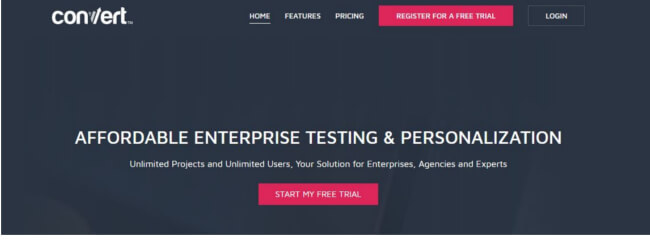
Source: Convert
Convert provides multi-domain A/B and multi-variable testing and tracking tools for both JavaScript, CSS and jQuery. With just a small piece of JavaScript code, you can create and edit your tests immediately as well as test your e-commerce products and category pages. Convert is very similar to Optimizely and VWO in terms of features and functionality, apart from its pricing structure. Convert’s prices start at $199 and vary quite a bit depending on the size of your company. This tool, in particular, caters more to the enterprise option.
Website: www.convert.com
Visual/Usability Feedback tools
Visual feedback tools are also often referred to as usability feedback tools. These types of tools are used by marketers and other user experience specialists to improve page usability by capturing input from their users as it comes in. Using these tools, you can point to specific page elements (including forms, images, buttons or paragraphs) and provide feedback on those page elements. Once an element is selected, the tool saves the screenshot with the user’s feedback. These tools are great for new websites and apps where the bugs or any unclear content needs to be identified quickly.
1. Helio

Source: Helio
With Helio you can collect and analyse visitor feedback from screens or test versions (mockups). You collect feedback, see what people remember about your design and what they think of it. Helio is a nice solution for testing ideas before they are implemented. You can get a basic count for $99 a month.
Website: www.helio.app
2. UserSnap

Source: UserSnap
UserSnap makes it easier to check for bugs and other issues. It also contributes to fast communication between designers, customers and employees. At the click of a button, visitors and designers can submit a bug report from the website. You can also create in-browser screenshots with this tool, so you can see exactly what your visitor sees without needing a plug-in. Pricing for Small to Medium businesses (SMB) range anywhere between €49 to €249 a month.
Website: www.usersnap.com
3. Bugherd

Source: Bugherd
Bugherd is a web-based issue tracking and project management software system for developers and designers. Like all of the other tools, it also has an in-page feedback option, allowing customers to report issues directly from the website. This enables you to see exactly which parts have been reported. Additionally, it includes project management tools, based on scrum. The software helps you convert customer feedback data into actionable tasks. The tool costs anywhere between $33 and $191 a month, with enterprise prices being available on request.
Website: www.bugherd.com
4. Marker.io

Source: Marker.io
Marker.io is a visual feedback and bug reporting tool for web professionals. With this tool you can convert screenshots from any website into a powerful bug report directly into your existing tools. What is unique about this tool is that the feedback is captured via a browser plug-in, rather than on the page itself so it must first be installed in Chrome before it can be used. Some key features are screenshot annotation tools, shareable links and workflow integration. Marker.io can be integrated with various scrum and project management tools such as Jira, Slack, Trello and Github. A paid account costs anywhere from $39 (starter) to $99 (team) a month with custom pricing for enterprises.
Website: www.marker.io
5. PageProofer
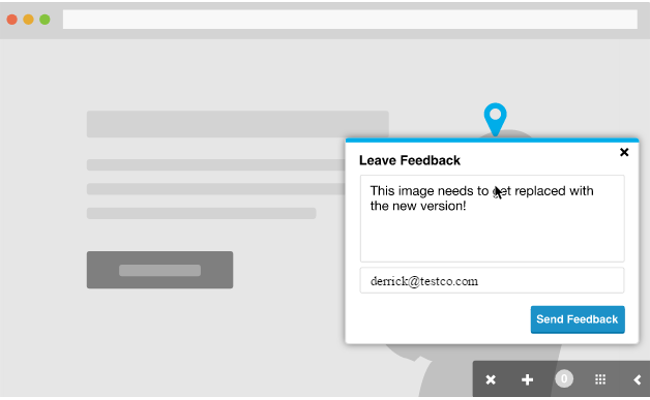
Source: PageProofer
PageProofer is a visual bug-tracking and feedback tool that works with sticky notes and screenshots. The tool offers real-time commenting and supports all browsers and devices. The dashboard shows all the notes including the full details on each one. When new notes are received, notifications can be sent to alert the development team in order to create a fast workflow. Prices vary from $39 to $199 a month, depending on the amount of users.
Website: www.pageproofer.com
Wireframing and UX design tools
UX design and wireframing tools are tools focused on the creation of new designs and developing concepts for funnels, landing pages, etc. These types of tools aid in the communication of ideas during the development process as they provide a visual representation of the design and lead to rapid prototyping.
1. MockFlow

Source: MockFlow
MockFlow is an online wireframe tool for software and websites, with an emphasis on collaboration and sharing. The tools has various functions including, drawing up user interface mockups, making design guidelines, creating and publishing websites, annotating images, and more. Pricing ranges anywhere from free (with limited use) to $27 a month (team package) with custom prices for enterprises.
Website: www.mockflow.com
2. Mockplus
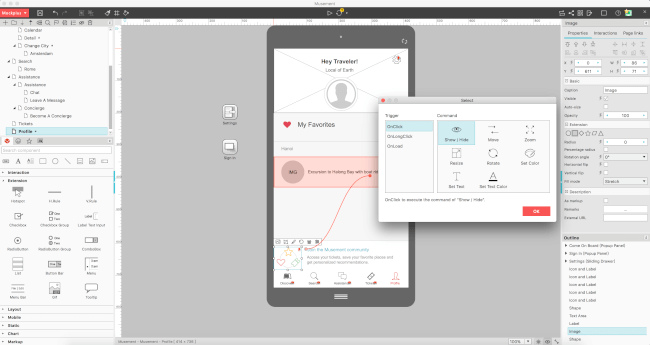
Source: Mockplus
Mockplus is a desktop-based application used for easy and rapid prototyping on platforms such as mobile apps, desktop apps and websites. Users do not need code or technical expertise to use this tool. With Mockplus you can create interactive prototypes in a minimum amount of time. This tool ranges from a free plan to $14.95 per user/month for the Ultimate plan and custom prices for enterprises.
Website: www.mockplus.com
3. Figma

Source: Figma
Figma is a collaborative, browser-based design tool for designers and developers. This software is great for product teams and includes handy features like commenting, prototyping without any code needed and standardised styles. Since the software is accessed with a browser, it makes it easy to access and share projects wherever you might be. Figma has a free plan and paid subscriptions that range from $1 to $75 a month.
Website: www.figma.com
4. Gliffy
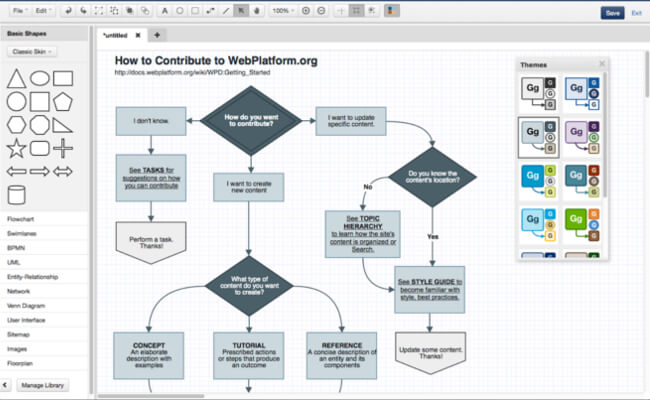
Source: Gliffy
Gliffy is a web-based diagram editor. In this tool, users can drag and drop components and export images. Users can also collaborate online and there is a version-tracking function included. It is recommended for personal use and/or smaller businesses. Pricing ranges between $6 to $8 a month depending on the amount of users or you can choose the enterprise option (custom pricing).
Website: www.gliffy.com
5. Lucidchart

Source: Lucidchart
Lucidchart is a cloud-based diagramming and visualisation tool. Users can map ideas with clients and colleagues in real-time. This tools is easy to use – for beginners and professionals. Lucidchart has a free plan and paid plans starting from $8. There is also an enterprise option with custom pricing.
Website: www.lucidchart.com
Choosing the right tools for your business
As you can see, there is a lot to choose from, no matter what your need is. Making the right choice all comes down to what you want to achieve and how far along your team or company is in terms of maturity.
So first things first. Have some goals in mind for what you want to achieve using the tool(s). Then take a look at how these sofware fit into your budget. While there are several tools that cater their services more towards enterprise businesses, there are also more cost-efficient options for smaller companies who, for example, might benefit more from a typical SaaS delivery model in which you pay per use (e.g. depending on how many users or website visitors you have). And lastly, don’t forget about the technical limitations. This includes factors such as IT restrictions when it comes to privacy or security (e.g. how and where data is stored). Depending on the possibilities IT-wise, you can choose between a self-hosted, open-source solution or an enterprise solution that will satisfy the needs of a larger organisation.
We hope this overview provides you with some inspiration in finding suitable UX tools.
Ready to see Mopinion in action?
Want to learn more about Mopinion’s all-in-1 user feedback platform? Don’t be shy and take our software for a spin! Do you prefer it a bit more personal? Just book a demo. One of our feedback pro’s will guide you through the software and answer any questions you may have.






